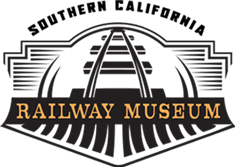Diesel Service Report, December 4th, 2021
SF560 Restoration Project
When the project was first announced, we asked for suggestions from fund donors as to what paint scheme they would prefer. We had the option of selecting between the original black and white zebra scheme or the blue and yellow scheme that was used in the last days of the Fairbanks Morse use with Santa Fe. The overwhelming majority chose the zebra scheme. Either scheme was totally acceptable from a historical perspective so choosing one or the other was really a toss-up. The final selection was to go with the zebra scheme.
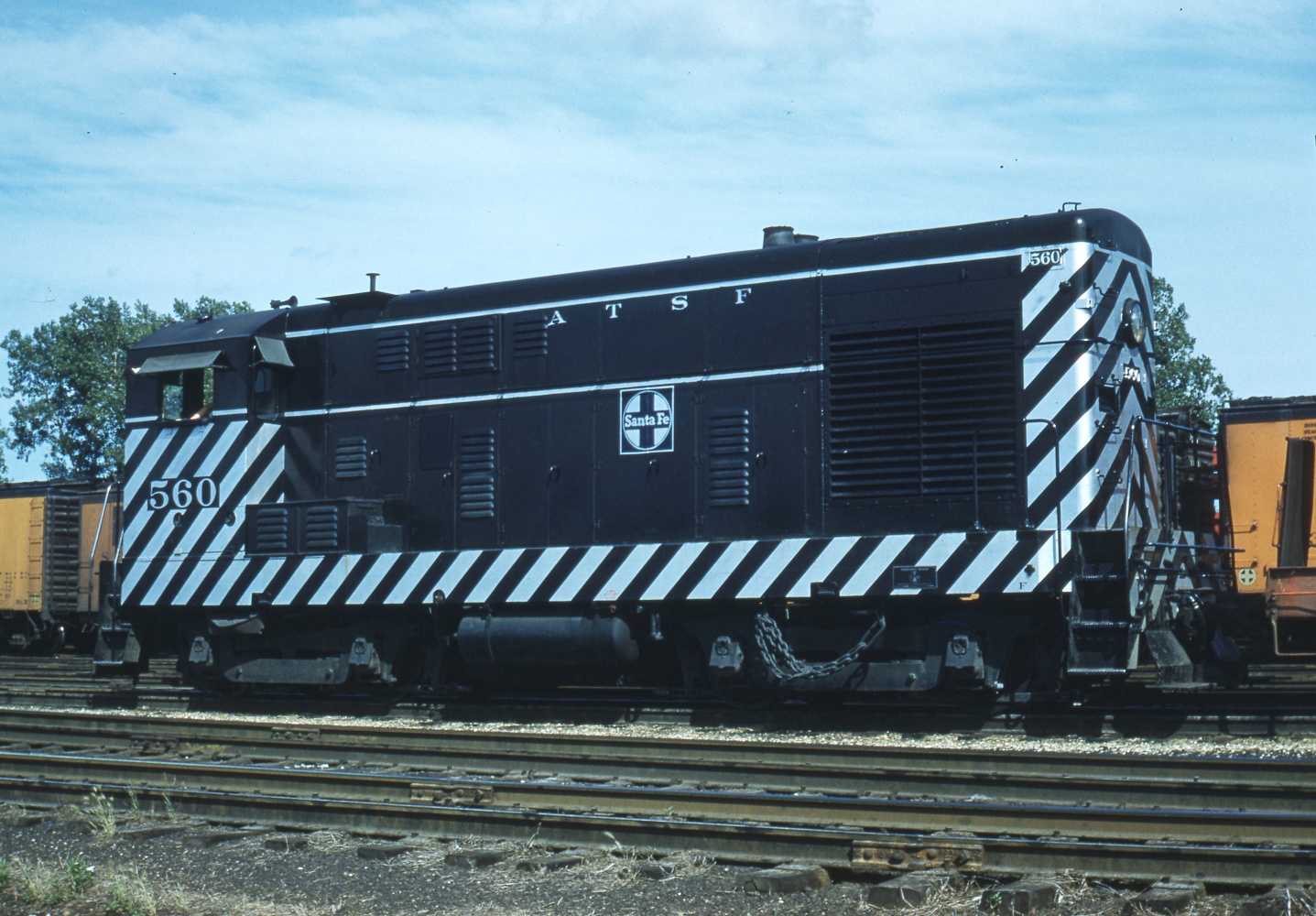
ATSF 560 North Kansas City 6-1-62 Louis Marre On transfer in Wabash yard.
Obviously, the zebra scheme will entail a lot more work due to the striping but its all within reason. However, selecting the zebra scheme also causes other changes to be made to restore the locomotive back to its original 1957 “as delivered” configuration. There weren’t any major changes done to the locomotive during its lifetime but there were a few things that needed to be done.
One of the first items was the relocation of the horn. Operating Engineers quickly learned that moving horns away from the cab area was much easier on their hearing. After the 1960’s, essentially all locomotives had their horn placements influenced by safety standards. But SF560’s original configuration was not ideal. It had the horn mounted on the side wall of the engine compartment directly in front of the engineer’s seat. Of course the horn front opening is pointing forward so most of the sound goes towards the front of the locomotive and not rearward towards the engineer.
Almost all of those style locomotives were retrofitted, and the horn was moved to the top of the cab roof. Of course, SF560 is being restored to its 1957 configuration so the horn has to be moved back to the side of the engine compartment.
Bob Bray and Tim Johnson spent the day installing the horn in its correct 1957 location. Once it was plumbed, they tried it. It is very loud. The horn valve is an existing one that was still on the locomotive. It will be replaced with a different valve that will fit better in that location.
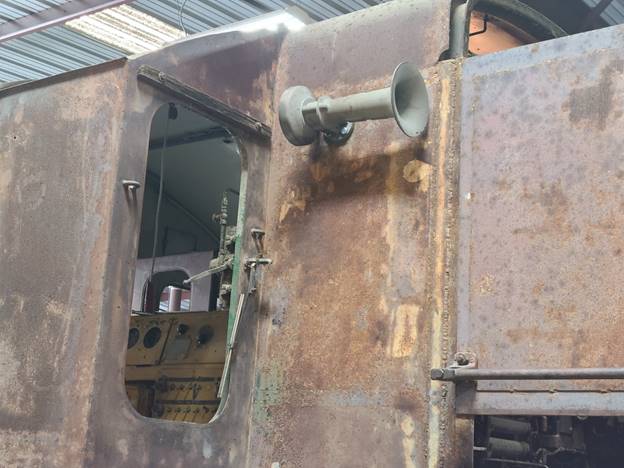 One interesting thing found during the horn installation was that the horn valve was plugged with a lot of fibrous type of material. That was very odd since there should be nothing like that in the air line. Once that material was cleaned out, the valve worked fine. But the question remained as to what the material was. Then it became clear. The air supply line goes through a shut off valve and a filter. And the filter is where the problem stemmed from. Back in the 1950’s, those filters were filled with “horse hair”. In the ensuing 60+ years, that horse hair had disintegrated and left the filter and became stuck in the valve. Most likely some of it also made its way into the horn itself. Now that we understand that, the filter will be removed and different filter media installed.
One interesting thing found during the horn installation was that the horn valve was plugged with a lot of fibrous type of material. That was very odd since there should be nothing like that in the air line. Once that material was cleaned out, the valve worked fine. But the question remained as to what the material was. Then it became clear. The air supply line goes through a shut off valve and a filter. And the filter is where the problem stemmed from. Back in the 1950’s, those filters were filled with “horse hair”. In the ensuing 60+ years, that horse hair had disintegrated and left the filter and became stuck in the valve. Most likely some of it also made its way into the horn itself. Now that we understand that, the filter will be removed and different filter media installed.
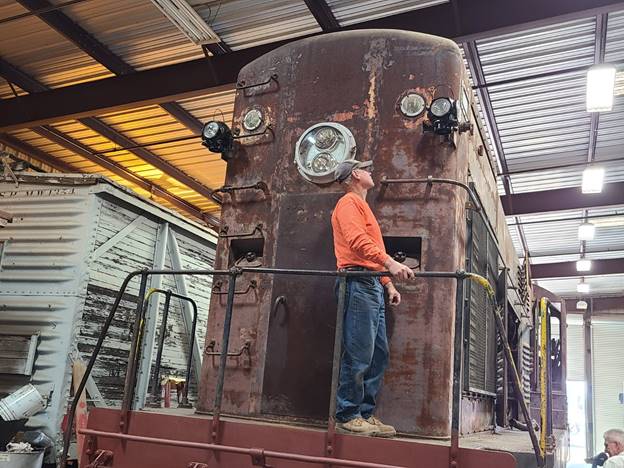 One of the next modifications that need to be addressed will be the reinstallation of original style removable class lights. Sometime around the time that Santa Fe went to their Blue and Yellow paint scheme, they cut new holes in the hood adjacent to the front headlight. These holes were for the more modern built-in class lights. In 2004, we didn’t know we would be refurbishing the locomotive back to its 1957 scheme and reinstalled a set of the newer class lights. Now those lights need to be removed and the holes in the hood closed up. We have the removable old style class lights ready to install. Carl Pickus will design an anti-theft lock system similar to the approach he used for SP1006’s class lights. The picture shows the black removable class lights in place plus the built in ones that will be removed.
One of the next modifications that need to be addressed will be the reinstallation of original style removable class lights. Sometime around the time that Santa Fe went to their Blue and Yellow paint scheme, they cut new holes in the hood adjacent to the front headlight. These holes were for the more modern built-in class lights. In 2004, we didn’t know we would be refurbishing the locomotive back to its 1957 scheme and reinstalled a set of the newer class lights. Now those lights need to be removed and the holes in the hood closed up. We have the removable old style class lights ready to install. Carl Pickus will design an anti-theft lock system similar to the approach he used for SP1006’s class lights. The picture shows the black removable class lights in place plus the built in ones that will be removed.
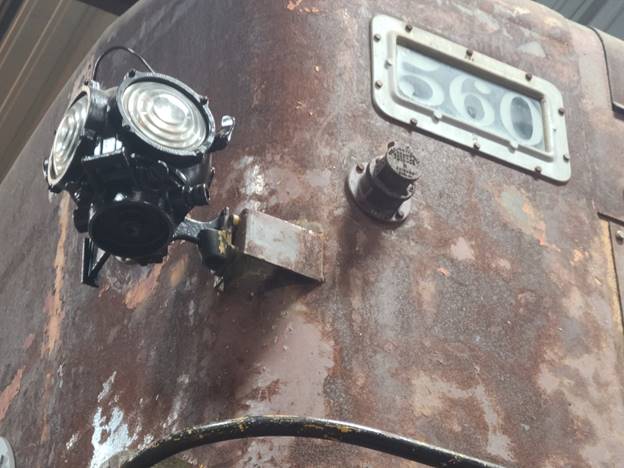 Originally the removable class lights would have had a short electrical cord that would plug into a socket that was mounted close by. The picture below shows that socket just to the right of the class light. We do not have the correct plug for the end of the electrical cord. We will try to find two of them but haven’t found them in the past. If we can’t find the correct plugs then we will hard wire the class lights, similar to what was done on SP1006.
Originally the removable class lights would have had a short electrical cord that would plug into a socket that was mounted close by. The picture below shows that socket just to the right of the class light. We do not have the correct plug for the end of the electrical cord. We will try to find two of them but haven’t found them in the past. If we can’t find the correct plugs then we will hard wire the class lights, similar to what was done on SP1006.
In the picture (right), the refurbished headlight has been reinstalled. Scott, our friend from back east, bead blasted all the aluminum frames. The rest of the refurbishment consisted of painting and a hinge replacement. Carl’s class light work is the only remaining work left associated with lighting.
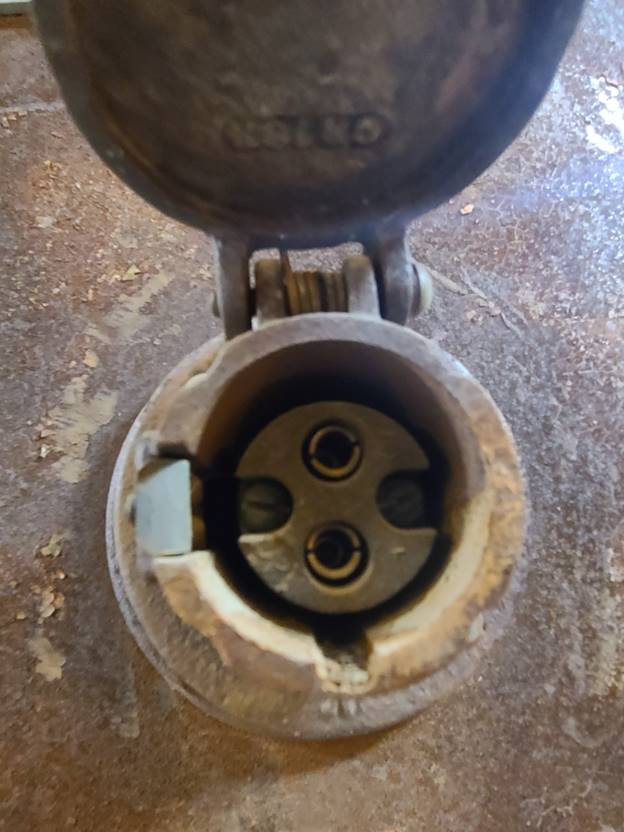 This (left) is what the inside of the socket looks like. It has two holes for electrical pins and two side holes that have the mounting screws. If any of you know where we can get two of these, please let us know.
This (left) is what the inside of the socket looks like. It has two holes for electrical pins and two side holes that have the mounting screws. If any of you know where we can get two of these, please let us know.
The engine compartment of SF560 is the dirtiest thing we have ever seen. There is no part of it that is free from years of deposited grease, oil, and dirt. Obviously our long term task is to clean up the whole mess and at least make the engine compartment presentable. It will never look new again but it has to be cleaned to some degree.
One of the options that will help this task is to have someone else do some of the cleaning. We decided to remove all of the engine access covers and take them to the radiator shop that cleaned our snubbers and air cleaners. That shop has the hot-dip tanks to remove all of the baked on grim from the covers. It will cost us to have them do the work but its worth it.
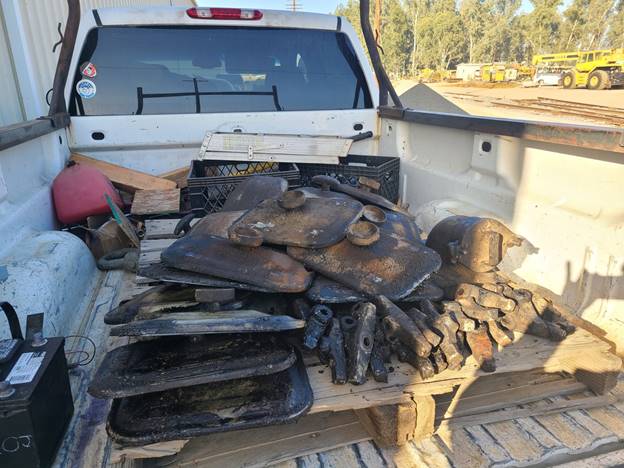 This (right) shows the pile of covers on a pallet in the back of Carl’s pickup. He and Doug Newberry will deliver them to the radiator shop this week.
This (right) shows the pile of covers on a pallet in the back of Carl’s pickup. He and Doug Newberry will deliver them to the radiator shop this week.
The pictures below show the side of the engine with the hand covers off. The round covers in the middle are the exhaust manifold inspection ports. These can be removed to inspect inside the manifolds for oil or carbon debris. Scott had already cleaned those prior to installation. They will be removed again and new high temperature gaskets installed.
Since this engine isn’t a V design, a person can look straight through the crankcase if the hand covers on both sides are are off. To say the least, the size of the crankshaft and piston rods are impressive. The engine high RPM is 850. That means the engine makes 14 complete revolutions every second when running wide open. That is thousands of pounds of moving parts rotating that fast.
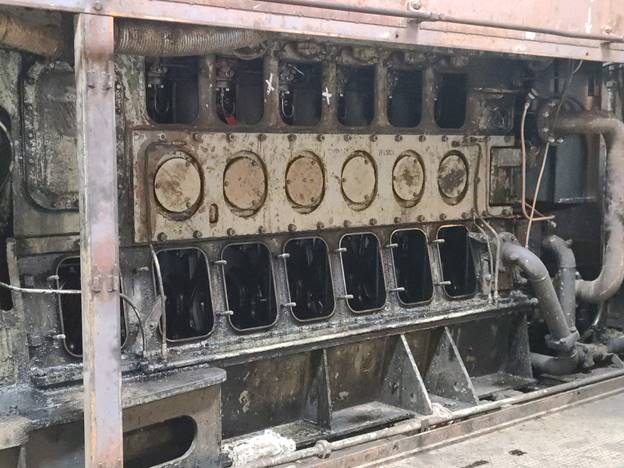
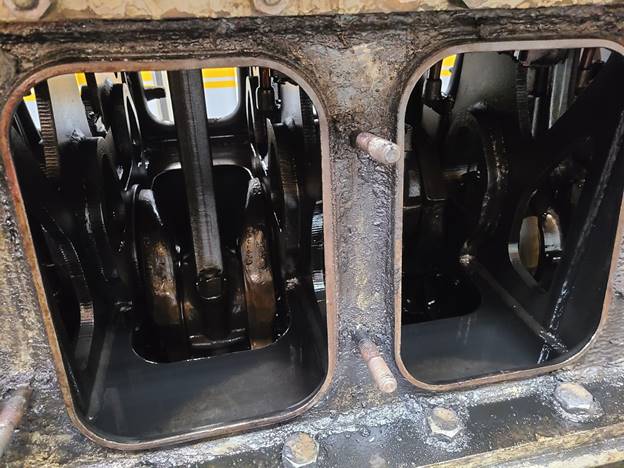
Operational Testing
John Salvini and Richard berk have continued to work towards getting the Diesel engine running satisfactorily. The engine has now been started numerous times and connected to the load bank twice. The first time on the load box, the engine ran at just over 300 HP for half an hour or so. The second time it was run at 900 HP for about 45 minutes. The engine is rated at 1200 HP so it was limited to about 75% of its full power rating.
During the 300 HP testing, problems were encountered with the governor control of the load regulator resistor. It was found that the pneumatic air line going from the throttle to the governor was leaking. Carl replaced it with a new copper line. The next test then allowed the engine to properly load to 900 HP.
That amount of load on the engine, is something that the locomotive hasn’t had since Santa Fe owned it in the 1970’s. Even then we don’t know if they tested it like this. What we do know is that at the higher load levels, serious problems that exist will readily show up, where they may not be evident at lower power levels. After 45 minutes of running at 900 HP, rubber hoses attached to the exhaust mufflers (snubbers) drains started to melt and the testing was shut down. It was clear that those rubber hoses were never supposed to be there. The correct hoses were originally made from flex or solid steel pipe. We will re-plumb those lines with the correct piping.
Other than the melting rubber hoses, the engine ran fine with a clear exhaust and no oil was being spit out the exhaust stack.
When the project initially got underway, we installed a used set of batteries. Those batteries no longer can turn the engine over fast enough for proper starting. A new set of batteries are on order and should arrive about the first week of January.
– Dave Althaus
